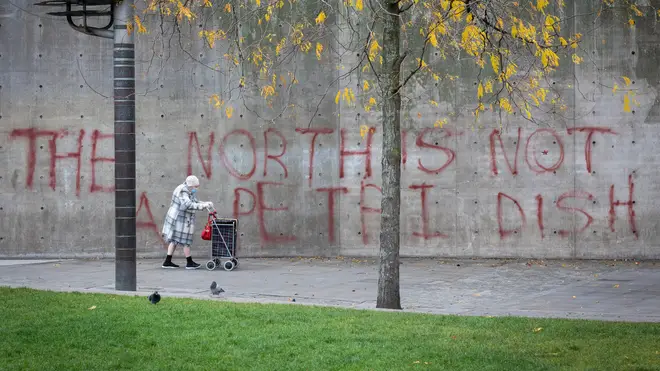
Clive Bull 1am - 4am
23 October 2020, 18:42

Governments across the UK have announced new restrictions and local lockdowns, but what is the difference between each country and different Tiers?
A two-week "firebreak" lockdown has been introduced across Wales from 6pm, with everyone "required to stay at home".
Nicola Sturgeon has also announced her own version of a Tiered system and parts of England have been put under stringent measures.
Here is how it breaks down in each region.
Read more: Wales brings 'fire-breaker' lockdown into force to curb Covid-19
A new three-tier system of coronavirus restrictions began last week.
Nationwide restrictions apply in Tier 1, which means people can meet in a group of up to six people from multiple households either indoors or outdoors, while pubs, bars and restaurants must close at 10pm.
Under the Tier 2 restrictions, people cannot meet with anyone they do not live with indoors unless they are part of a support bubble, while the rule of six applies for socialising outside.
Areas in Tier 2 currently include: London, Essex. Coventry, Slough, Cheshire, the West Midlands, Leicestershire, West Yorkshire and Nottinghamshire.
The most severe level of restrictions, Tier 3, means people cannot socialise with anyone outside their household in any indoor and many outdoor settings. Pubs and bars are forced to close unless they can operate as a restaurant.
Areas in Tier 3 include Greater Manchester, the Liverpool City Region and Lancashire.
South Yorkshire will move to Tier 3 from Saturday.
You can look at the Government's map showing each different Tiered region here.
Read more: Millions of people in England and Wales face tougher covid rules

People react as Wales begins it's 17 day "firebreak"
A two-week "firebreak" lockdown will begin on Friday evening and last until November 9.
Residents will be told to "stay at home" unless they are critical workers, and only primary schools and secondary schools for Years 7 and 8 will reopen after half term.
Supermarkets have also been banned from selling "non-essential" items, as other retailers are forced to close for the two-week period.
First Minister Mark Drakeford said: "We are looking to minimise the amount of time that people spend out of their homes during this two-week period.
"This is not the time to be browsing around supermarkets looking for non-essential goods."
It is currently not clear what classes as "essential" goods.
Tighter coronavirus restrictions announced by Stormont First Minister Arlene Foster came into force in Northern Ireland last Friday.
Pubs and restaurants have been closed for four weeks, with the exception of takeaways and deliveries, while schools are closed for two weeks - one of which will cover the half-term Halloween break.
Retail outlets will remain open, as will gyms for individual training.
People should work from home unless unable to do so, and are urged not to take unnecessary journeys.
Read more: Number of Covid-19 patients dying in England highest since May
Listen & subscribe: Global Player | Apple Podcasts | Google Podcasts | Spotify
First Minister Nicola Sturgeon has announced a new five-tier system for Scotland.
Every part of the country will be placed into grades ranging from a baseline of Level 0 up to the highest Level 4.
The five levels represent an advancing scale of lockdown restrictions and are expected to come into force on November 2.
Level 4 will be close to full lockdown restrictions seen at the end of March, while Level 3 will ban hospitality venues from selling alcohol indoors and outdoors and will close entertainment venues.
Less severe Level 2 will mean that households cannot mix in homes, but in Level 1 mixing inside homes and outdoors will be limited to six people from two households.
In Level 0 which will have the loosest restrictions, most businesses will be allowed to stay open and gatherings indoors will be capped at eight people from three households.
However, travel to other areas with Level 3 or 4 restrictions - and areas of the other home nations with similar rules - will be banned.
Until the Levels come in, existing rules banning household mixing and closing pubs and restaurants in central Scottish districts remain in place.
Ireland is effectively back under lockdown for the next six weeks as ministers approved a nationwide move to Level 5 restrictions.
Under the restrictions, schools and creches will remain open, no social or family gatherings will be allowed in homes or gardens, but visits on compassionate grounds and for caring purposes can continue.
Attendance at weddings will be maintained at 25 guests.
Restaurants, cafes and bars will be permitted to provide takeaway services only. Only essential retail may remain open.
People are being asked to stay at home, with exercise permitted within a 5km radius of their home.
The rules will last until December 1.